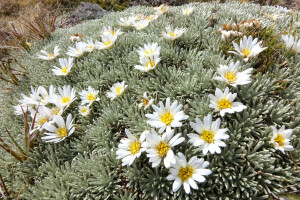Key to Celmisia in New Zealand
David Glenny, Jane Gosden, Rowan Hindmarsh-Walls
This key relies a great deal on the first three features in the key: leaf lamina length, leaf width, and distribution by province. The factsheets with each species provide detailed distributions that will refine the choice of province. We have attempted to make a non-technical key but a ruler is needed to measure leaf lamina length and width and a hand-lens to see hairs or their absence on the achenes.
The key was initially scored from H. H. Allan’s 1961 (Flora of New Zealand volume 1) and papers published since by David Given and Bill Lee between 1969 and 1984 (Given 1969a, 1971, 1980; Lee and Given 1984). Species, subspecies, and varieties were rescored more accurately using herbarium specimens. Distributions were compiled using the Celmisia collection at the Allan Herbarium, Lincoln.
Subspecies recognised by David Given in his series of papers on Celmisia have been accepted but not most of the varieties in Allan’s 1961 flora. Five exceptions are: Celmisia lateralis var. villosa, C. haastii var. tomentosa, and C. hieraciifolia var. gracilis, C. macmahonii var. hadfieldii and C. ramulosa var. tuberculata.
Given’s (1969) arrangement of subgenera and sections remains the only complete classification of the genus (Saldivia, 2024). As Saldivia (2024) points out only subgenus Pelliculatae has been almost completely revised by Given (1969a, 1972, 1975, 1980, 1984) while the other four subgenera recognised by Given (1969) have not been revised.
We have avoided making novel taxonomic decisions over species (e.g. Celmisia adamsii, C. major, and C. graminifolia). However, providing detailed distributions for each species necessitated adopting a concept of each species and this often involved examining type specimens. The classification adopted here is almost the same as that of Jane Gosden’s “Mountain Daisies. A guide to Celmisia in Aotearoa/New Zealand. Manuka Press 2024).
Hybrids in Celmisia are common in the wild and are a source of confusion. Hybrids often have an obvious resemblance to one of the parent species, so knowledge of the species and noticing the species nearby helps in their recognition. Only one common hybrid has been added to the key, C. xpseudolyallii. A list of the most common hybrids is provided in the key's introductory notes.
Acknowledgements
We thank contributors of Celmisia images to iNaturalist who have generously allowed reuse of their images by giving them creative commons licences: Alex Fergus, Andrew Townsend, Bert Filemyr, Cara-Lisa Schloots, Chris Ecroyd, Chris Morse, Colin Meurk, Dave Holland, David Lyttle, Emily Roberts, Greenschist, Harry Lurling, J. M. de Spa, Jacqui nz, Jesse Blythell, John Barkla, Katy Johns, Lloyd Esler, Marley Ford, Marshy, Oscar Grant, Peter de Lange, Peter Sweetapple, Roger Frost, Sarah Richardson, and Shirley Kerr.


